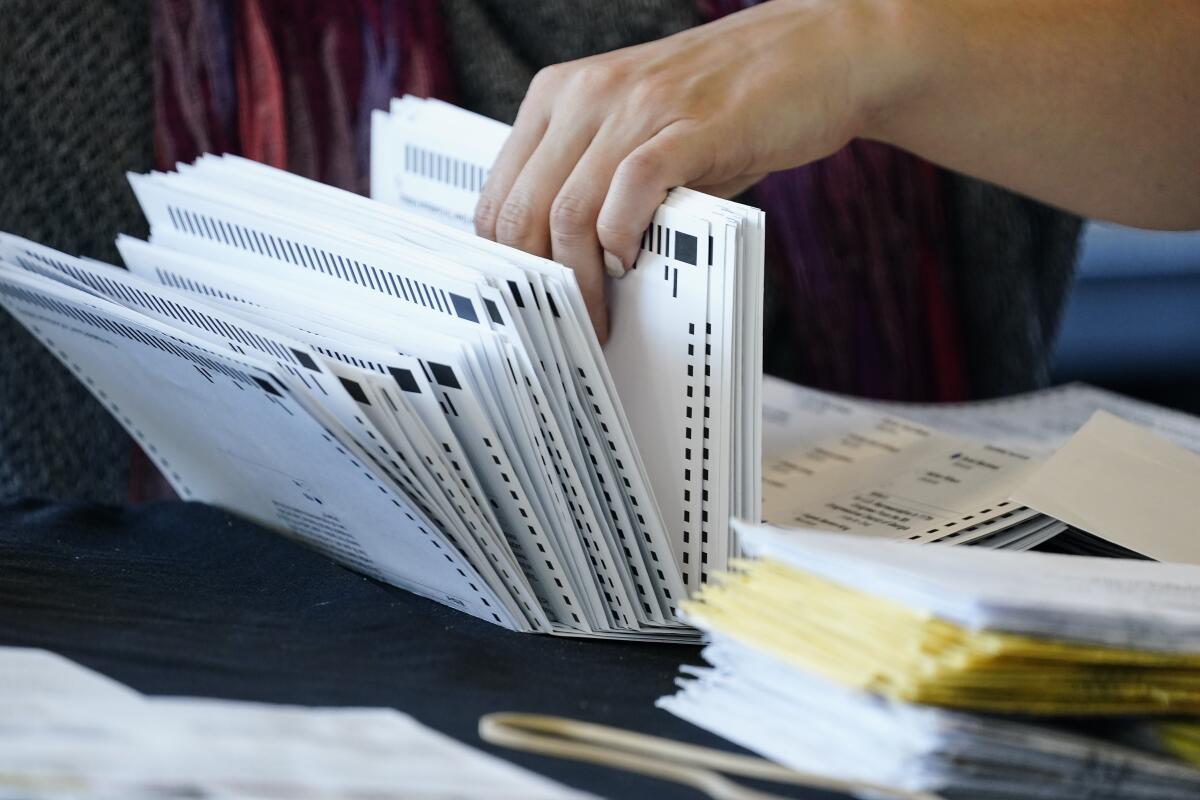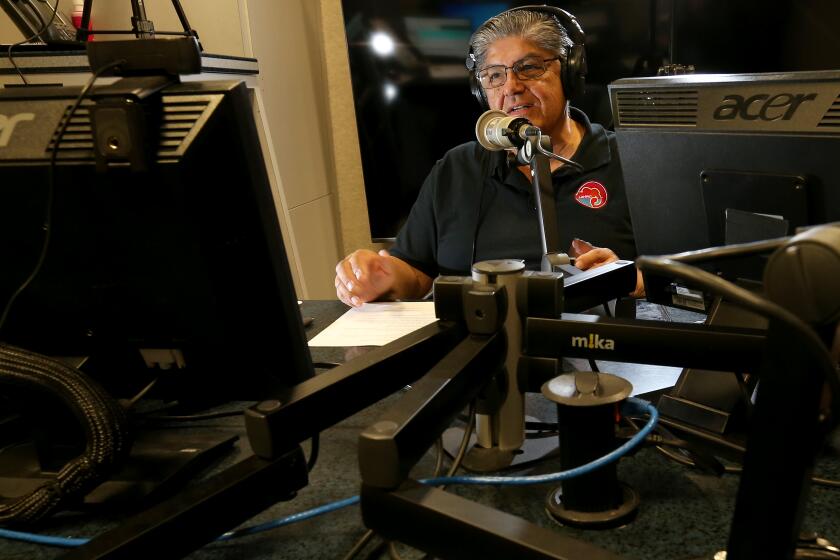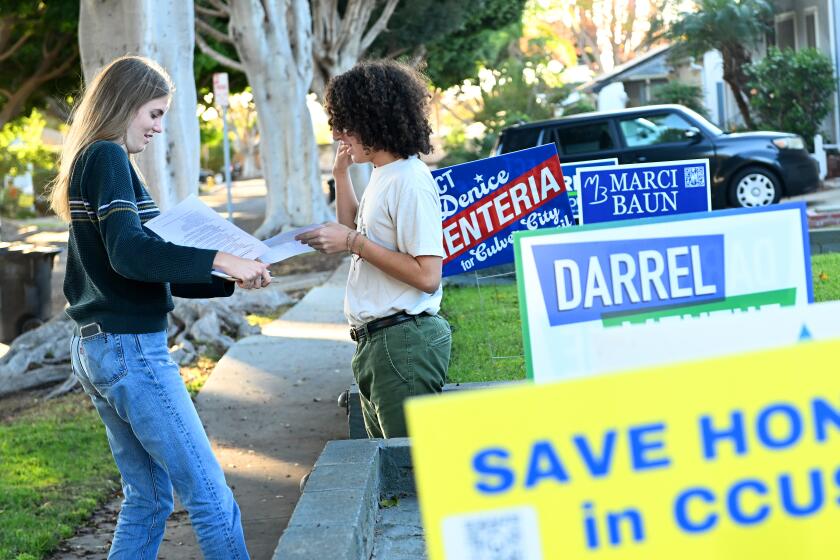Get ready to wait for the midterm results

- Share via
If you’re planning an election night party, there’s something you should know: The results are going to take a while. It could be days before the outcome of these midterms is determined — maybe weeks if there are runoffs and recounts.
In fact, it may be time to retire the terms “election day” and “election night” altogether. It’s more like “election season.” Better stock up on chips and salsa.
This turn of events is not cause for alarm, contrary to some conspiracy theories. It’s a sign that every vote is being carefully counted, and that some states have increased participation in elections by expanding access beyond specific polling places during specific hours on a specific day.
Each state gets to decide how to run its elections. In Brandeis’ famous phrase, the states are “laboratories of democracy” within our political system.
The latest poll shows Karen Bass and Rick Caruso in a dead heat. I can’t help but wonder what it would mean for racial and ethnic relations in L.A. if she lost.
There are many commonalities across the country. Forty-six states offer in-person early voting. More than half allow voters to cast absentee or mail ballots for any reason. Eight states mail out ballots automatically to all those who are registered.
But each state also customizes procedures as it thinks best — democracy in action.
In Colorado, where every voter gets a mail ballot, election officials begin checking signatures and validating ballots as they arrive. Actual counting starts 15 days before election day, but totals can’t be released until the physical polls close.
In Michigan this year, clerks in larger cities can start processing mail-in ballots two days ahead of Nov. 8, but they can’t start counting them until that morning. Wisconsin and Pennsylvania, on the other hand, don’t even open absentee or mail-in ballot envelopes until the day of the election.
As you might expect, the results take shape differently too. Many states can and do report early and absentee results soon after polls close, along with their same-day votes. But states that don’t get a head start on processing absentee and mail-in ballots won’t have complete results quickly.
Even in the speediest states, results trickle in. The numbers you see on Tuesday night will not be final. Those in the media who “call” elections may be able to accurately gauge the outcome in many states and races. But with so many contests shaping up to be very close, and tens of millions of early, mail and absentee votes to count, we can’t expect to end Tuesday with certainty. Some big implications of this election — for example, which party will control the next Congress — may not be clear.
We learned this lesson in 2020, when news sources waited four days to declare Joe Biden the president-elect and when control of the Senate wasn’t determined until January, after a runoff in Georgia.
The show is at its best when the hosts focus on Los Angeles-area politics. When they try to swing national, it’s just like any other right-wing babblefest.
Our varied approach to voting may not offer instant gratification, but it works: Elections in the United States are remarkably accurate. States’ professional audits and recounts prove it. Georgia counted its votes three times in 2020, and the outcome was unchanged.
Among the many tragedies of the “Big Lie“ — the fiction that Donald Trump was denied victory in 2020 by rampant election fraud — is needless hostility toward our state-based system. Some wonder why we can’t be more like other countries, where elections are centralized and results seem to be immediate.
But our federalist patchwork quilt is also a safety mechanism. America’s elections are more secure because they’re decentralized. More than 200,000 polling places were used in the 2018 midterm elections, with reporting rolling up through precincts, counties and states. Such an individualized system is impossible to hack. Of course, there are things we can learn from other countries, and there is always room for some uniform, nationwide processes. But we should also value our state variations.
As more than 60 court cases proved, allegations of rampant fraud in 2020 were pure nonsense. Unfortunately, they have flooded into 2022. Politicians across the country are campaigning on outright lies about our elections. Some have even suggested that if they lose, they won’t accept the outcome.
State election officials, admirably, are responding with sunlight — explaining to voters exactly what the counting process will look like, and counseling patience.
California is the latest target in a movement to grant 16- and 17-year-olds the right to vote in municipal elections. The option is on the ballot in this city.
In Michigan, Secretary of State Jocelyn Benson told voters to expect unofficial statewide results about 24 hours after the polls close. Professional administrators will prioritize accuracy over speed, she said.
“Voters should be wary of the likelihood that some may seize on this time and space to spread misinformation and lies about the tabulation process and preemptively claim results,” Benson said. “Remember that only a full tabulation of every valid vote will determine the winner in any election contest.”
In Pennsylvania, which could have more than 1.4 million mail and absentee votes to count, Leigh Chapman, the acting secretary of the commonwealth, carefully walked voters through the process on the state’s website and in an op-ed in Pennsylvania newspapers. She explained that representatives of candidates and political parties will observe every step. “An accurate count is paramount and cannot be rushed,” she wrote.
As we wait for results, we should take our cues from these responsible state officials.
So settle in. Be wary when any candidate claims victory before the full results are clear. Give state and local officials time and space to do the work of verifying and counting. If TV analysts’ touch-screen maps are filling in too slowly for you, take a deep breath, pull up a livestream of the vote count and be assured that the process is working.
Our elections take time for the best of reasons: In America, we count every valid vote so everyone has a voice.
That’s worth throwing a party for.
Joanna Lydgate, Norm Eisen and Christine Todd Whitman are co-founders of States United Action, a nonpartisan group focused on protecting U.S. elections.
More to Read
A cure for the common opinion
Get thought-provoking perspectives with our weekly newsletter.
You may occasionally receive promotional content from the Los Angeles Times.












